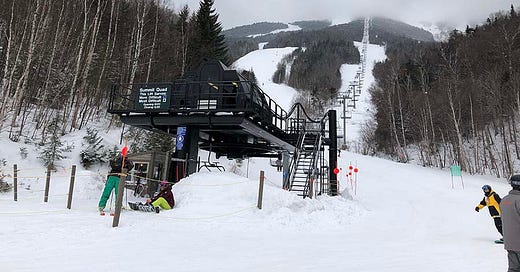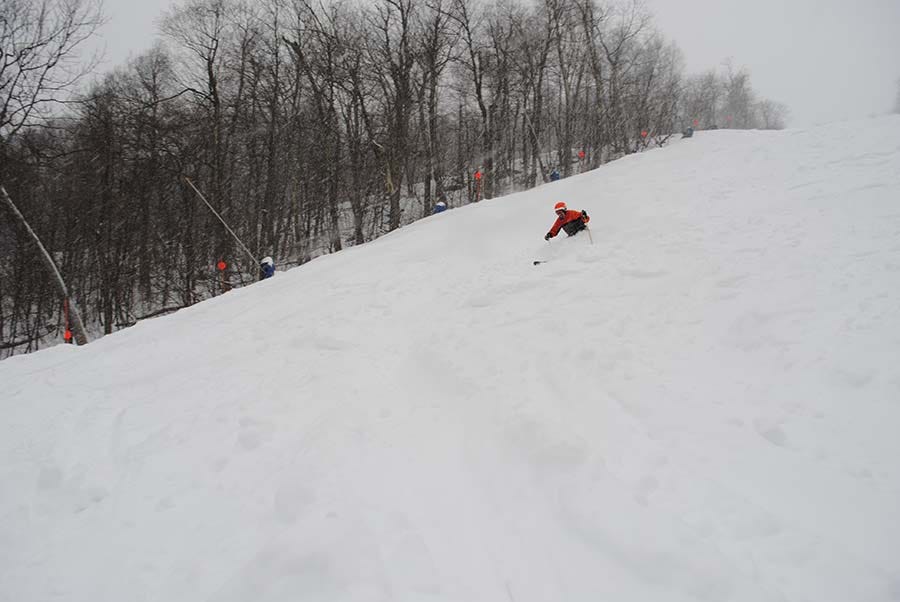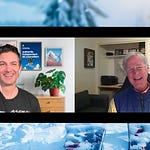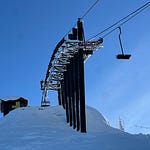The Storm Skiing Podcast is sponsored in part by:
Mountain Gazette - Listen to the podcast for discount codes on subscriptions and merch.
Helly Hansen - Listen to the podcast to learn how to get an 18.77 percent discount at the Boston and Burlington, Vermont stores.
Who
Scott Brandi, President of Ski Areas of New York
Recorded on
May 17, 2021
Why I interviewed him
Because I spent this winter wandering the snowy New York backroads, rootless and curious, my compass aimed toward snow. I was determined to drive out my prejudices against the small and the homey, to overrule an ingrained Vermont-centrism whose calculus commanded that no roadtrip over four hours could land anywhere else. Covid required this reconsidering. But I had a pass to Hunter and could have simply lapped Catskills steeps all winter. Instead I explored. I visited, for the first time, Maple Ski Ridge, Snow Ridge, Oak Mountain, Dynamite Hill, Labrador, Song, Mount Peter, Victor Constant, Toggenburg, Four Seasons, Titus, Holiday Mountain, Willard, Royal, Hunt Hollow, Swain, and West. I poached runs on the closed slopes of Indian Lake, Newcomb, and Schroon Ski Center. And of course I hit the old familiars: Hunter and Plattekill and Belleayre and Windham and Gore. And what I found is that New York skiing is a rich world, varied and surprising, understated and retro in a way that’s neither ironic nor deliberate. Don’t tell the hipsters – they’ll sew a “locally made” patch onto the wicket tickets and drive prices up 300 percent. But talk to Scott Brandi all you want about it. As the leader of Ski Areas of New York for the past 14 years, there was no one better positioned to fill out my understanding of this sprawling lift-served world.

What we talked about
Ski NY’s mission and business model; how many of New York’s 50-plus ski areas the association represents; assisting the town tows who can’t afford membership but do so much to grow the sport; whether Vail will yank Hunter from Ski NY like they pulled their mountains out of Ski Colorado; transforming Ski NY from an indebted organization into a profitable one; lawmaking and lobbying; why the industry prioritizes self-regulation; pending bills in the New York State legislature and how they might affect ski areas; how the ski industry has changed since Brandi took over Ski NY in 2007; the origins of New York State’s lift maintenance program; how New York State handed out $5 million for energy-efficient snowguns; why the exact number of ski areas in the state is so confoundingly elusive; the newly lost New York ski area in need of an operator; the chances of a comeback for Hickory, Big Tupper, or Shu-Maker; lessons we can learn from Cockaigne’s resurrection; New York’s 2020-21 skier visit estimate; the Covid outdoor recreation boom; the surprise ski area sellouts and how that may translate into the future; New York’s Olympic facilities and whether the state could ever host the Winter Games again; the upcoming World University Games in Lake Placid; ORDA’s non-ski-area investments; why New York’s culture of family-owned ski areas continues to thrive; New York’s lack of ski-in, ski-out lodging and whether that could ever change; why we’re unlikely to ever see another new ski area in New York State; how Big Tupper’s comeback was strangled by litigation; thoughts on the arrival of the Epic, Ikon, and Indy passes in New York; whether the New York Gold Pass will make a comeback; teaming up with the State of New York and the NSAA to prepare for the 2020-21 Covid ski season; getting through the ski season without a single ski-area shutdown; the New York State license plate program; the state’s knockout Kids Passport program, how the state kept it going during Covid, and whether it will once again include weekends next season; why more people don’t use the programs; and New York Ski Day and whether it will come back in 2022.
Questions I wish I’d asked
I wanted to talk a bit about New York’s private ski club culture, as it probably has more substantial members-only ski areas – Buffalo Ski Center, Holimont, Hunt Hollow, Skaneateles, Cazenovia – than any other state (most are open to the public on weekdays). Ski NY also partners extensively on adaptive ski programs, and I wanted to chat about those a bit. But we already ran long and I wanted to give Scott his day back.
What I got wrong
I forgot the name of the global winter sporting event that New York is hosting in 2023 and that it’s been preparing for for years, calling it “the World something games” as though I was conducting a man-on-the-street interview for a third-tier late-night talk show. Brandi smoothly pointed out that this event will be called the World University Games. Not exactly forgetting your wife’s name at the altar but damn man I gotta do better next time.
Why you should ski New York
New York skiing can be a tough sell. Yes, it has more ski areas than any other state, but all of them combined could probably fit comfortably into the boundaries of Park City. Whiteface has the tallest vertical drop in the East and the 11th biggest in the country, but its “Iceface” nickname is well-earned, and it doesn’t get the snowfall of the Tug Hill bumps – McCauley, Snow Ridge, Dry Hill – to its west. And the state is right next to snowy and built-up Vermont, the mountains of its powder-smashed Green Mountain spine laced with high-speed lifts and towering over ample on-site lodging. Snow, modern lifts, ski-in-ski-out – all of these are rare in New York. In fact, it’s one of the most curious ski states in the nation, as I’ve written before:
Someone built New York skiing backwards. It’s biggest and best ski areas – Whiteface, Gore, the four Catskills mountains – receive substantially less snow on average than the far smaller ski areas ringing the state’s Great Lakes borderlands. Twin lake effect snow bands blast off the eastern ends of Lakes Erie and Ontario, clobbering Midwest-sized ski hills with monstrous snow dunes. 500-vertical-foot Snow Ridge, tucked into the Ontario snow pocket along with 300-foot Dry Hill, 633-foot McCauley, and 500-foot Woods Valley, gets buried in 230 inches of annual snowfall. By comparison, Whiteface, towering three-ish hours to the east, makes due with 185 inches on average.
New York skiing is hard to understand. It has more ski areas than any other state, but they don’t really make sense. They’re scattered all over the place. Most are at least somewhat challenging to access. A couple are enormous but most are not.
But, as Brandi notes on the podcast, that geographic dispersal means that no matter where you live in New York State (outside of Long Island), you’re no more than two hours from skiing. And since most of the mountains don’t have 32-passenger catapult lifts or farm-to-table juice bars or hell even RFID gates, their passes tend to be affordable. I’ve been tracking season pass prices for New York and every other Northeast state here, but here are a few examples:
A joint pass for Song and Labrador is $499. Song is a bit smaller but is a better pure skier’s mountain.
Royal Mountain, with its small footprint but wide-open woods and steady pitch, offers a $390 pass (it’s a weekends-only operation).
New York has five Indy Pass mountains, meaning passholders can add the multipass for $189 ($89 for kids). They are: West ($599 adult), Swain ($499), Snow Ridge ($410), Catamount ($499), and Greek Peak ($595). The Catamount pass is also good for unlimited access to Berkshire East (Massachusetts’ best ski area), and Bousquet. Add unlimited Toggenburg access to a Greek Peak pass for $50. West, Snow Ridge, and Greek Peak have already passed their early-bird deadline, which drove prices up substantially.
Most of these are affordable enough to be a fair complement to an Epic or Ikon pass, so you can get some regular turns in between runs out West or to New England. There’s no reason to ski every once in a while when you can ski all the time.

Additional resources
The definitive source for New York ski stoke is the excellent New York Ski Blog, where I am a semi-regular contributor. Run by stokemaster and all-around good dude Harvey Road, the site’s email newsletter is a must-add to your inbox. My favorite post of this past winter was Harvey’s recap of his four-day tour of Plattekill, Snow Ridge, Gore, and McCauley – probably my top four ski areas in the state. My New York contributions were write-ups of visits to Maple Ski Ridge and Willard.
Support Ski NY by purchasing a poster, license plate, or merch.
New York’s Ski & Ride Passport program is incredible. If you have a 3rd- or 4th-grader, they get up to three lift tickets at each participating ski area (that’s most of them), with the purchase of an adult lift ticket. The program was modified to weekdays-only this past season, but Ski NY anticipates once again including weekends for 2021-22.
If you liked what Brandi has to say, you’d probably also like the Storm Skiing Podcast interviews with National Ski Areas Association CEO Kelly Pawlak and Ski Vermont President Molly Mahar.
Past New York-focused podcasts include West Mountain owners Spencer and Sara Montgomery, Windham President Chip Seamans, Berkshire East and Catamount owner Jon Schaefer, and Plattekill owners Danielle and Laszlo Vajtay. If you run a mountain in New York (or, frankly, anywhere else), I want to talk to you on the podcast.















Share this post